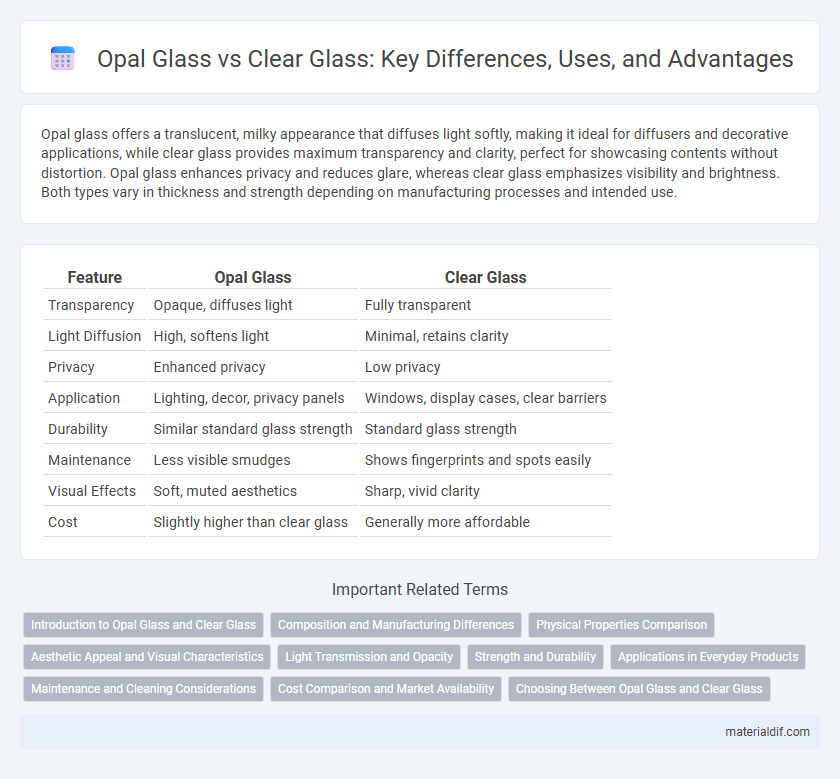Opal glass offers a translucent, milky appearance that diffuses light softly, making it ideal for diffusers and decorative applications, while clear glass provides maximum transparency and clarity, perfect for showcasing contents without distortion. Opal glass enhances privacy and reduces glare, whereas clear glass emphasizes visibility and brightness. Both types vary in thickness and strength depending on manufacturing processes and intended use.
Table of Comparison
| Feature | Opal Glass | Clear Glass |
|---|---|---|
| Transparency | Opaque, diffuses light | Fully transparent |
| Light Diffusion | High, softens light | Minimal, retains clarity |
| Privacy | Enhanced privacy | Low privacy |
| Application | Lighting, decor, privacy panels | Windows, display cases, clear barriers |
| Durability | Similar standard glass strength | Standard glass strength |
| Maintenance | Less visible smudges | Shows fingerprints and spots easily |
| Visual Effects | Soft, muted aesthetics | Sharp, vivid clarity |
| Cost | Slightly higher than clear glass | Generally more affordable |
Introduction to Opal Glass and Clear Glass
Opal glass is a type of opaque or translucent glass characterized by its milky white appearance, achieved by adding fluorides or phosphates to the glass mixture, making it ideal for decorative and functional uses such as lighting fixtures and tableware. Clear glass, also known as transparent glass, is composed primarily of silica, soda, and lime, offering high clarity and light transmission, widely used in windows, bottles, and optical applications. Both types differ significantly in optical properties and applications, with opal glass providing diffuse light diffusion and clear glass emphasizing transparency and visibility.
Composition and Manufacturing Differences
Opal glass is composed primarily of silica mixed with opacifying agents such as bone ash or fluorides, which create its characteristic milky white appearance, while clear glass mainly consists of silica with soda and lime, resulting in its transparent quality. Manufacturing opal glass requires careful control of raw material proportions and higher temperature firing to achieve uniform opacity, whereas clear glass undergoes standard melting and cooling processes to maintain clarity. The presence of opacifiers in opal glass affects its thermal and optical properties, making it suitable for decorative and functional uses where light diffusion is desired, unlike clear glass which is preferred for transparency.
Physical Properties Comparison
Opal glass exhibits higher opacity and diffuses light more effectively than clear glass, making it ideal for applications requiring privacy and soft illumination. Clear glass offers superior transparency and higher clarity, allowing maximum light transmission and visual acuity. In terms of thermal properties, opal glass typically has lower thermal conductivity, providing better insulation compared to clear glass.
Aesthetic Appeal and Visual Characteristics
Opal glass features a milky, translucent appearance that diffuses light softly, offering a subtle, elegant aesthetic ideal for ambient lighting and decorative applications. Clear glass provides a transparent, crisp look that enhances clarity and visibility, making it suitable for displays, windows, and products requiring unobstructed views. The diffused, matte finish of opal glass contrasts with the glossy, reflective surface of clear glass, influencing the overall visual impact and design style.
Light Transmission and Opacity
Opal glass, characterized by its milky white appearance, offers reduced light transmission and higher opacity compared to clear glass, making it ideal for diffusing light evenly while minimizing glare. Clear glass provides superior light transmission, typically allowing up to 90% or more of natural light to pass through, resulting in maximum transparency and clarity. The choice between opal and clear glass depends on the desired balance between illumination and privacy, with opal glass favored in applications requiring softened, diffused light.
Strength and Durability
Opal glass exhibits enhanced strength and durability compared to clear glass due to its unique composition that includes opacifying agents, which create a denser and more robust material. This increased density provides better resistance to thermal shocks and mechanical impacts, making opal glass ideal for applications requiring longevity and toughness. In contrast, clear glass, while offering superior transparency, generally has lower structural integrity and is more susceptible to breakage under stress.
Applications in Everyday Products
Opal glass, characterized by its milky, translucent appearance, is widely used in lighting fixtures and decorative items to diffuse light softly and reduce glare, enhancing aesthetic appeal in homes and offices. Clear glass, known for its transparency and clarity, is preferred in applications requiring unobstructed visibility such as windows, glassware, and display cases, emphasizing functionality and visual cleanliness. Both types cater to distinct practical and design needs in everyday products, with opal glass excelling in ambient lighting and clear glass in visibility and protection.
Maintenance and Cleaning Considerations
Opal glass requires gentle cleaning agents and non-abrasive tools to prevent surface damage and maintain its matte finish, unlike clear glass which can tolerate a wider range of cleaning products and methods. The porous nature of opal glass makes it more susceptible to staining and requires more frequent maintenance to preserve its appearance. Clear glass offers easier cleaning and better resistance to scratches and stains, making it a preferred choice for high-traffic or heavily used areas.
Cost Comparison and Market Availability
Opal glass typically costs 20-30% more than clear glass due to its specialized manufacturing process and opaque properties. While clear glass dominates global market availability, opal glass serves niche markets such as lighting fixtures and decorative applications where diffusion and aesthetics are prioritized. Limited suppliers and higher production complexity restrict opal glass availability compared to the widely accessible clear glass in construction and packaging industries.
Choosing Between Opal Glass and Clear Glass
Opal glass offers a translucent, diffused light effect ideal for creating soft, glare-free illumination, making it suitable for decorative lighting and privacy applications. Clear glass provides maximum transparency and clarity, enhancing visibility and natural light transmission, which is essential in display cases, windows, and optical instruments. When choosing between opal glass and clear glass, consider the desired level of light diffusion, aesthetic preferences, and functional requirements such as privacy or visibility.
Opal glass vs Clear glass Infographic

 materialdif.com
materialdif.com